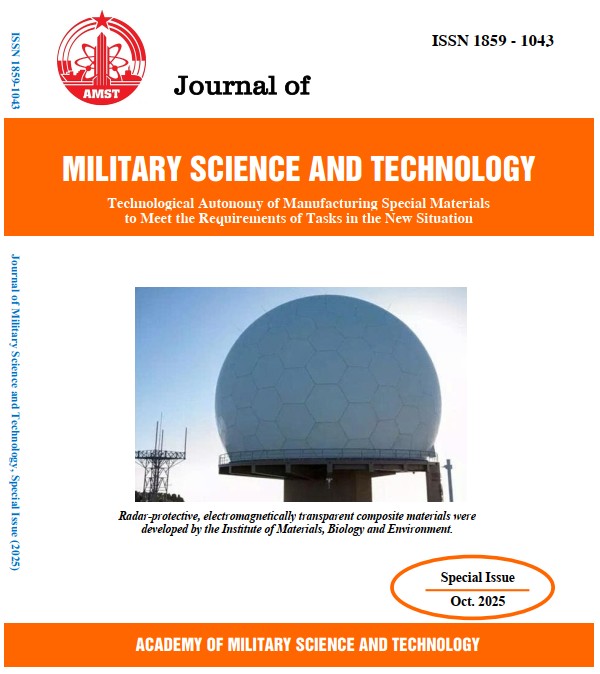Selection of drought and salinity tolerant water spinach (Ipomoea aquatica) lines through somaclonal variation
225 viewsDOI:
https://doi.org/10.54939/1859-1043.j.mst.IMBE.2025.144-150Keywords:
Water spinach; Somaclonal variation; Mannitol; NaCl; Callus; Drought and salinity tolerance.Abstract
This study applied tissue culture and artificial stress treatments to develop drought- and salinity-tolerant water spinach (Ipomoea aquatica) lines. Calli from the DL1 cultivar were dehydrated via sterile air-blowing (2–10 h) to induce somaclonal variation, and then regenerated plantlets were screened for stress tolerance. Drought tolerance was tested with mannitol (15–45 g/L) and salinity tolerance with NaCl (0.5–2.0%). A 10-minute HgCl₂ treatment produced the highest survival (66.67%), though additional disinfection was necessary. Callus regeneration declined with longer dehydration; 2 h was optimal. The combination of 15 g/L mannitol and 2 weeks of air-drying achieved the highest plantlet survival (85.74%). Salt tolerance peaked at 0.5–1.0% NaCl, above which survival dropped sharply. Sixteen somaclonal lines with enhanced drought and salinity tolerance were obtained. The results highlight in vitro–induced somaclonal variation under combined physical and chemical stress as a practical approach for breeding stress-resilient leafy vegetables for climate change adaptation.
References
[1]. Lampe, Johanna W., "Health effects of vegetables and fruit: assessing mechanisms of action in human experimental studies", The American Journal of Clinical Nutrition, 70(3), 475S–490S, (1999). DOI: https://doi.org/10.1093/ajcn/70.3.475s
[2]. Qiong Su et al., "The growing trend of saltwater intrusion and its impact on coastal agriculture: Challenges and opportunities", Science of The Total Environment, 966, 178701, (2025). DOI: https://doi.org/10.1016/j.scitotenv.2025.178701
[3]. Karp, A., "Somaclonal variation as a tool for crop improvement", Euphytica, 65(1), 245–256, (2012).
[4]. Das, P. et al., "Mutagenesis: Exploring Novel Genes and Pathways", Wageningen Academic, 15–36, (2014). DOI: https://doi.org/10.3920/978-90-8686-787-5_1
[5]. Nevo, E., & Chen, G., "Drought and salt tolerances in wild relatives for wheat and barley improvement", Plant, Cell & Environment, 33(4), 670–685, (2010). DOI: https://doi.org/10.1111/j.1365-3040.2009.02107.x
[6]. Saikat Paul, “Biotechnologies of Crop Improvement”, Vol. 2, Springer International, 141–181, (2018). DOI: https://doi.org/10.1007/978-3-319-90650-8_7
[7]. Sharma, M. et al., "Technological advancements in the CRISPR toolbox for improving plant salt tolerance", Discover Agriculture, 2, 102, (2024). DOI: https://doi.org/10.1007/s44279-024-00105-3
[8]. Islam, M. M. et al., "Use of somaclonal variation to improve drought tolerance of rice (Oryza sativa L.)", Bangladesh Journal of Botany, 34(1), 55–61, (2005).
[9]. Sharma, S. K. et al., "In vitro selection for abiotic stress tolerance in potato (Solanum tuberosum L., Advances and prospects)", Plant Cell, Tissue and Organ Culture, 88(1), 1–14, (2007).
[10]. Mital N. Manvar et al., "Phytochemical and pharmacological profile of Ipomoea aquatica", Indian Journal of Medical Sciences, 67(3–4), 49–60, (2013). DOI: https://doi.org/10.4103/0019-5359.121115
[11]. Murashige, T., & Skoog, F., "A revised medium for rapid growth and bioassays with tobacco tissue", Physiologia Plantarum, 15, 473–497, (1962). DOI: https://doi.org/10.1111/j.1399-3054.1962.tb08052.x
[12]. George, E. F. et al., Plant propagation by tissue culture (3rd ed.), Springer, (2008). (Sách)
[13]. Ikeuchi, M. et al., "Plant callus: mechanisms of induction and repression", The Plant Cell, 25(9), 3159–3173, (2013). DOI: https://doi.org/10.1105/tpc.113.116053
[14]. Nguyen Thi Lan et al., "Ảnh hưởng của mannitol lên khả năng chống chịu hạn của cây rau muống (Ipomoea aquatica)", CTU Journal of Science, 55(3), 71–78, (2019) (in Vietnamese). DOI: https://doi.org/10.22144/ctu.jvn.2019.110
[15]. Nguyen Van Hung et al., "Ảnh hưởng của mặn đến sinh trưởng của cây rau muống nuôi cấy in vitro", Journal of Vietnam Agricultural Science and Technology, 3(5), 89–95, (2020) (in Vietnamese).
[16]. Ashraf, M., & Foolad, M. R., "Roles of glycine betaine and proline in improving plant abiotic stress resistance", Environmental and Experimental Botany, 59(2), 206–216, (2007). DOI: https://doi.org/10.1016/j.envexpbot.2005.12.006
[17]. Sivanesan, I. et al., "In vitro propagation of sweet potato (Ipomoea batatas L.) under salt stress conditions", Plant Tissue Culture and Biotechnology, 21(1), 1–8, (2011).







